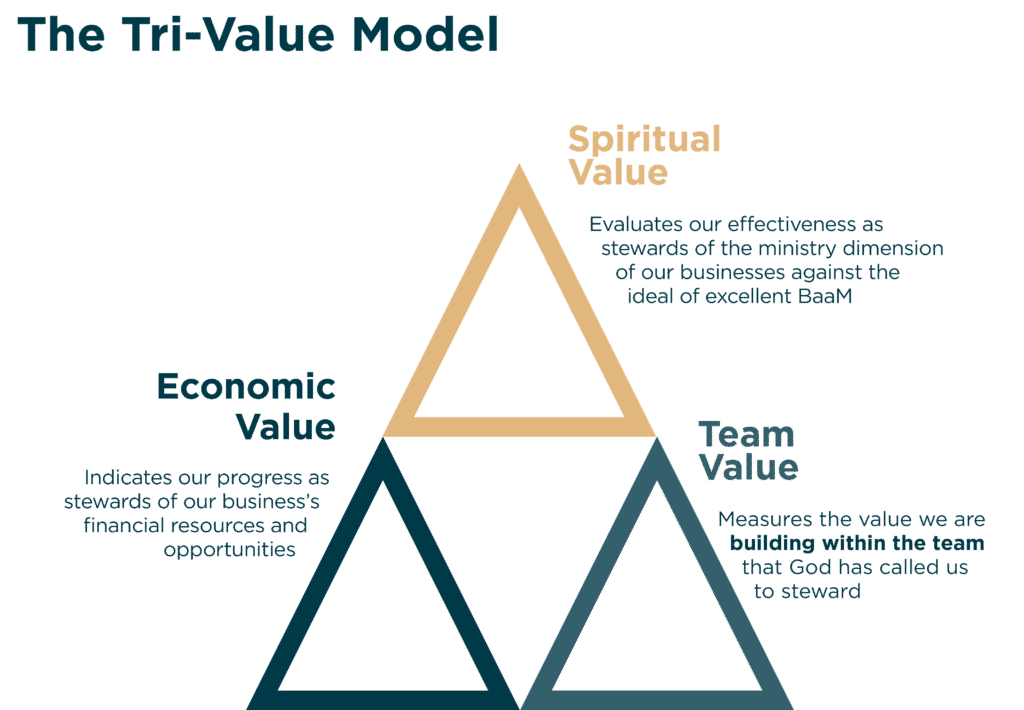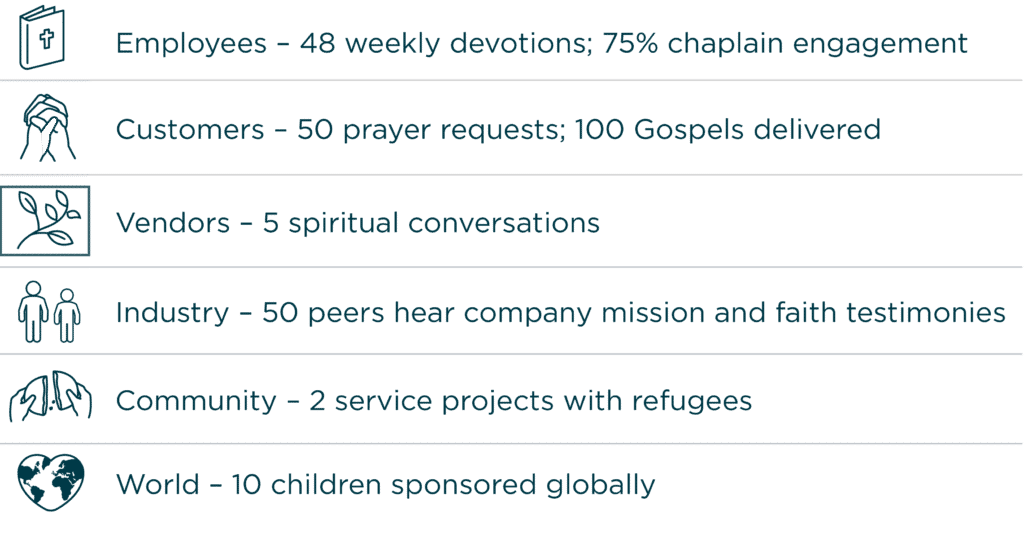Using Key Performance Indicators (KPIs) to Measure the Ministry Impact of Your Business
As business leaders, we know the importance of measurement. We track revenue and sales numbers on a weekly or even daily basis. We measure overhead and costs to eliminate inefficiencies. We calculate the effectiveness of our marketing campaigns by clicks and conversions. Measurement helps us track goals and increase performance.
Christian CEOs, who seek to honor God with their businesses, often live with an unsettling conviction.
In addition to economic performance, these leaders care about their impact on people. And while they know how to measure their companies’ economic effectiveness, measuring their personal and spiritual impact seems much more challenging.
C12’s Tri-Value model provides Christian leaders with a framework to evaluate their business effectiveness. This model emphasizes the importance of a three-factor approach to business: economic value, team value, and spiritual value.

When leaders focus on team and spiritual value, in addition to economic value, they exponentially increase their impact on people. We refer to this integrated approach as Business as a Ministry, or BaaM.
This three-factor approach prompts Christian CEOs to ask some challenging questions.
- Have we identified specific BaaM strategies that increase team and spiritual impact among our people?
- How can we know if we are achieving our vision for impact?
Brandon West is a C12 member and the Chief Purpose Officer at PHOS Creative, a digital marketing agency with 21 employees headquartered in Florida. PHOS is committed to delivering excellence to clients while exemplifying the love of Christ. While that BaaM mission is evident on their website, PHOS employees struggled to see how their daily work actually advanced that mission.
Brandon wondered how he could motivate his employees and help them see the impact they were having through their BaaM initiatives.
The Importance of Measurement
Peter Drucker famously said, “You can’t manage what you don’t measure.”
This observation kick-started an obsession with business metrics and the drive to define and improve Key Performance Indicators (KPIs). A good KPI is specific, measurable, and impactful to overall business goals.
For leaders working to build God-honoring businesses, new metrics are needed to quantify the Business as a Ministry (BaaM) goals envisioned in the three-sector approach of the Tri-Value Model: economic value, team value and spiritual value.
Measuring BaaM impact helps leaders:
- Demonstrate the collective impact of multiple contributions
- Focus efforts on the most fruitful activities
- Uncover hidden needs in and around the business
- Create accountability to live out the company’s values
Why Leaders are Reluctant to Measure BaaM
Although leaders understand the importance of utilizing KPIs in their business operations, some Christian CEOs resist measurement in their Business as a Ministry (BaaM) initiatives.
Common concerns are:
- Measuring ministry will cheapen the activity
- Scorekeeping will lead to legalism or a works orientation
- Higher ministry visibility will cause legal issues
- Ministry metrics will be hard to measure
While these concerns are real, they are not insurmountable. With vision, a plan, and peer support, hundreds of leaders have pushed through the challenges to implement effective BaaM initiatives in their businesses with a measurable impact.
One Christian CEO, a C12 member, regularly asks himself this challenging question: “If my business grows threefold, but doesn’t scale its BaaM impact, is it really successful in God’s eyes?”
Measuring ministry efforts is a discipline unique to the BaaM paradigm. Just as business leaders use KPIs to meet economic objectives, effective BaaM leaders will put KPIs in place to quantify spiritual and team objectives.
Measuring in the Bible
The Bible records numerous instances where God led His people to measure their efforts in a spiritual context.
- Numbers 1 and Numbers 26 recount Moses’ two meticulous censuses, a detailed counting of the number of people in each of Israel’s 12 tribes.
- In Acts 2:41, Luke counts 3,000 saved on the Day of Pentecost.
- Jesus’ loaves and fishes miracle counted 5,000 followers fed in Matt 14:13-21.
At C12, one of our core values is Results Matter. “God measures results and so should we.”
This begs the question: How can we bring the same data-driven discipline to measure the impact of our BaaM efforts that we bring to other business objectives?
Determining Our BaaM Metrics
Building a Business as a Ministry (BaaM) requires the same disciplines and best practices most leaders already employ: setting targets, developing execution plans, and measuring progress.
While most business leaders are comfortable quantifying success metrics in the economic sector of the Tri-Value Model, they struggle to determine appropriate BaaM metrics for the team and spiritual sectors.
The goal-settling experience of our colleagues in the social sector can be instructive. In his monograph Good to Great for Social Sectors, Jim Collins suggests social sector leaders operate under a different set of metrics. He says:
“A great organization is one that delivers superior performance and makes a distinctive impact over a long period of time … For a social sector organization, however, performance must be assessed relative to mission, not financial returns. In the social sectors, the critical question is … How effectively do we deliver on our mission and make a distinctive impact, relative to our resources?”
– Jim Collins
Thus, Christian CEOs who want to effectively incorporate BaaM initiatives into their businesses will need to adopt a unique both/and mentality. These leaders will operate under two sets of metrics: 1) performance metrics to measure the business’ economic goals and 2) ministry metrics to measure the business’ spiritual and team impact.
Just like every business’ economic metrics are different, every business’ BaaM metrics will be unique to their specific culture, passions, and interests. Some business owners provide financial support for employees to adopt children out of foster care. Others support local food banks, encourage chaplaincy, or experience mission trips together.
Eligibility Consultants Inc. (ECI) has a mission to alleviate the burden of unpaid medical bills by helping patients access state and federal programs. When a patient receives aid, ECI’s president sends the recipient a pocket Gospel of John with a letter to express how their debt relief points to a debt that was paid by Jesus Christ.
Over the years, the ECI team has taken the rubber bands from each bundle of Gospels to create a large rubber band ball. The growing ball serves as a scorecard, a visual reminder of the business’ greater purpose to transform lives. (You can hear more by watching the video on C12’s YouTube Channel).
Some other examples of BaaM metrics could include:

To identify which BaaM metrics may fit for your organization, ask:
- What would increased care look like for people in our company?
- What are the leading and lagging indicators that inform our sense of ministry fruitfulness?
- Thirty years from now, what metrics would we be most proud of?
C12’s 105 Business as a Ministry Ideas e-book is a robust resource that our members reference often to inspire new ways to increase their spiritual impact in the business.
Inspiring Engagement and Impact
Once we decide on the Business as a Ministry (BaaM) strategies that are right for our business, our next step is to track, assess, and report on our BaaM activities over time.
And just like we invite and empower others on our teams to advance specific business objectives, we should invite and empower others to help advance our BaaM objectives. Identify the people in your organization whose passions align with your ministry goals. The more we empower these people to own a specific objective, the more our ministry activities become a part of the culture.
C12’s BaaM Scorecard Template is a customizable spreadsheet that will give you a jumpstart in developing a measuring discipline. This tool will help you identify your key initiatives, assign owners, and track progress toward goals.
Your BaaM goals should “spur you on to love and good deeds.” (Hebrews 10:24) And it’s okay to start small. The intent is to increase sincere people-oriented behavior and meaningful outcomes over time. Approach your BaaM metrics with a spirit of grace to learn, adjust, improve, and celebrate.
Yes – celebrate!
When BaaM efforts feel genuine to the organization, metrics can become a source of employee motivation and celebration.
Illuminating the Marketplace
When Brandon West at PHOS met with one of the company’s interns, he realized his employees didn’t fully understand the impact of their work. So he created a powerful visual to change that.
Organizations measure what matters. At a C12 Business Forum, you can become part of a growing movement of business leaders who measure the light of their team—their spiritual impact alongside their economic impact.
Let’s multiply the light together!
Our monthly Business Forums gather peers to equip them for growth, share ideas, and provide accountability. Find a C12 Business Forum in your area.
February 16, 2022





